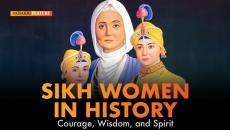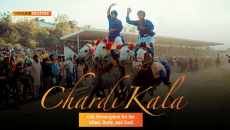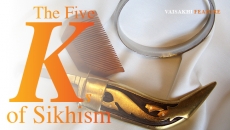Punjabi names—Jaswinder, Rupinder, Sharnjeet, Harpinder, Gurparveen—carry the gravity of history and identity. Yet, sometimes, their multiple vowels leave others stumbling. So, we wring out the richness, condense them into Jas, Rup, Sharn, Harp, Gurp—names that fit neatly into mouths unaccustomed to the syllables of the land of five rivers.
When my name was chosen, it wasn’t a random decision—it was a collaboration between the Almighty and my family. The Guru Granth Sahib gifted me a beginning. The letter ‘ਹ’(ha-ha)—became Harpreet, meaning the one who loves God. But growing up, I’d slice my name in half, making it smaller, easier. I’d listen to the effortless way others’ names rolled off tongues, watch how easily they were remembered. In classrooms, I shrank my name into something less noticeable—Harp. A name that wouldn’t take up too much space or time. My Punjabi would whisper to me, asking why it was always measured against English, like that cousin every brown mom constantly brags about. I ignored its voice.
Then, one day, my Nani made me see my name differently. Her full name was Gurmej Kaur Hayer. Jokingly, I told her I’d start calling her GKH—to make her sound hip and cool. She laughed but replied in Punjabi, "I like my name. It’s the name my parents gave me; the name God wanted me to have. Why would I change a gift from God?"

I’ve never seen God, but my Nani was the closest I’d ever gotten. And in that moment, it felt like she was passing down a piece of divine wisdom.
Slowly, I realized my name wasn’t meant to be whispered. Punjabi isn’t quiet—it’s a language that speaks in bold, a language with its volume on loud. My name is a privilege, a gift shaped by ancestors who knew how to roar. It carries the courage of my Nani, who raised five children. It carries the strength of my mother, who packed her bags and left home for Canada to give me a better future. It carries the resilience of my parents, who worked long shifts and early mornings so I could have a voice. Why hide a name woven from sacrifice and love? Why not say it with pride?
Sikh names aren’t just names. They are blessings, drawn from a sacred book of poetry and wisdom. There is power in hearing a full Punjabi name pronounced, each letter rolling off the tongue like a hymn, purifying the space it enters. A bit of God lingers in these names.
Our names are more than just words; they are a greeting, a Sat Sri Akal. They are a firm handshake from an uncle, a tight embrace from a Bibi who just wants to feed you. They are long, accent-heavy, and deeply intentional—crafted by God, presented to us so that when we say them, we ignite an emotion.





